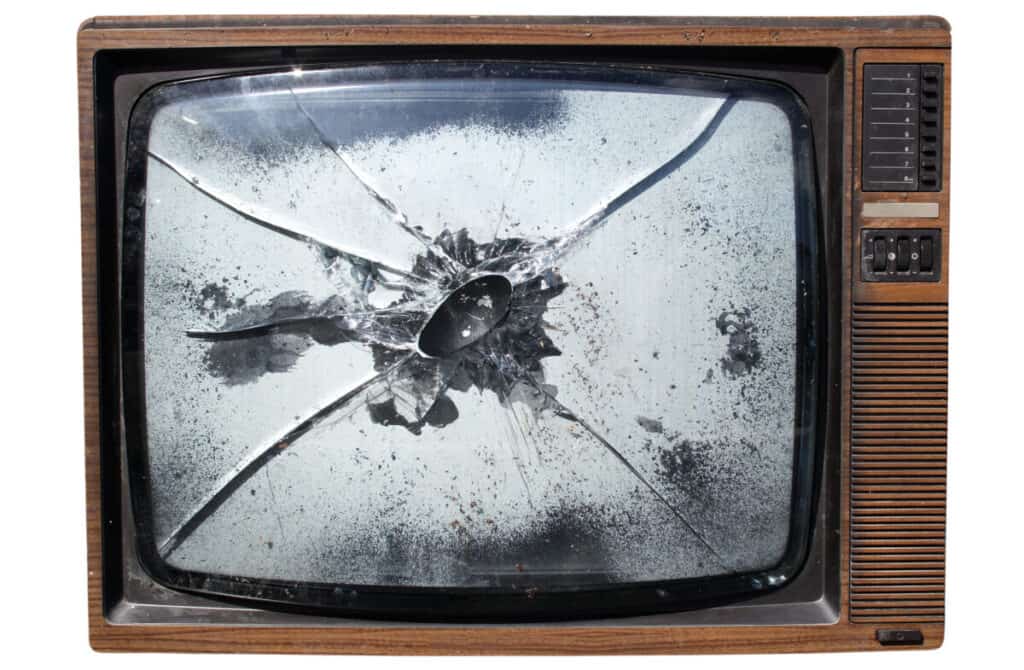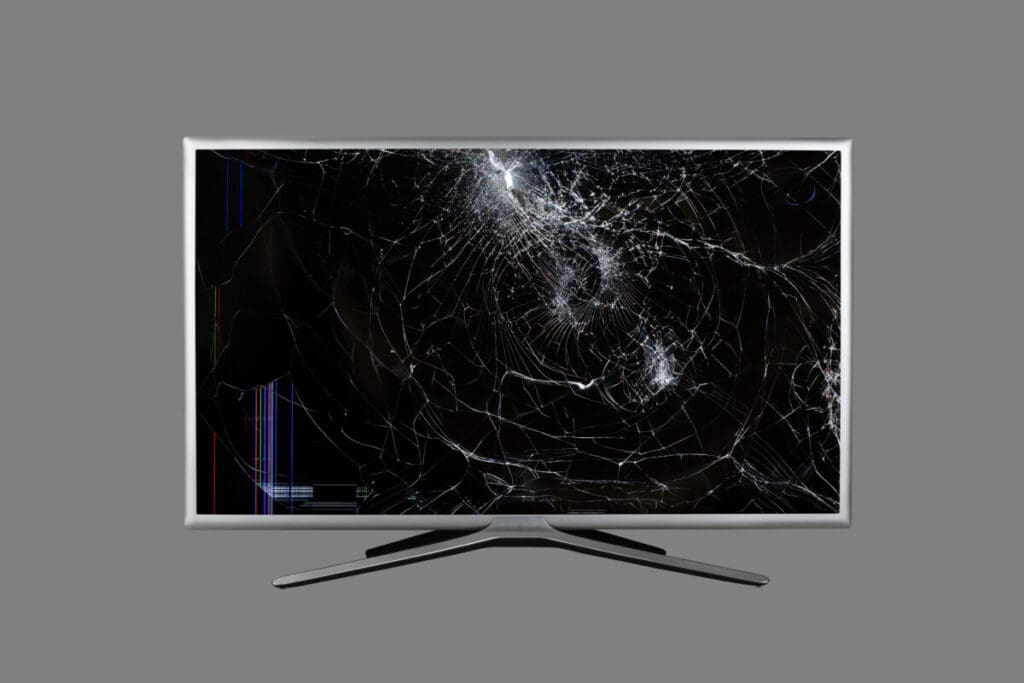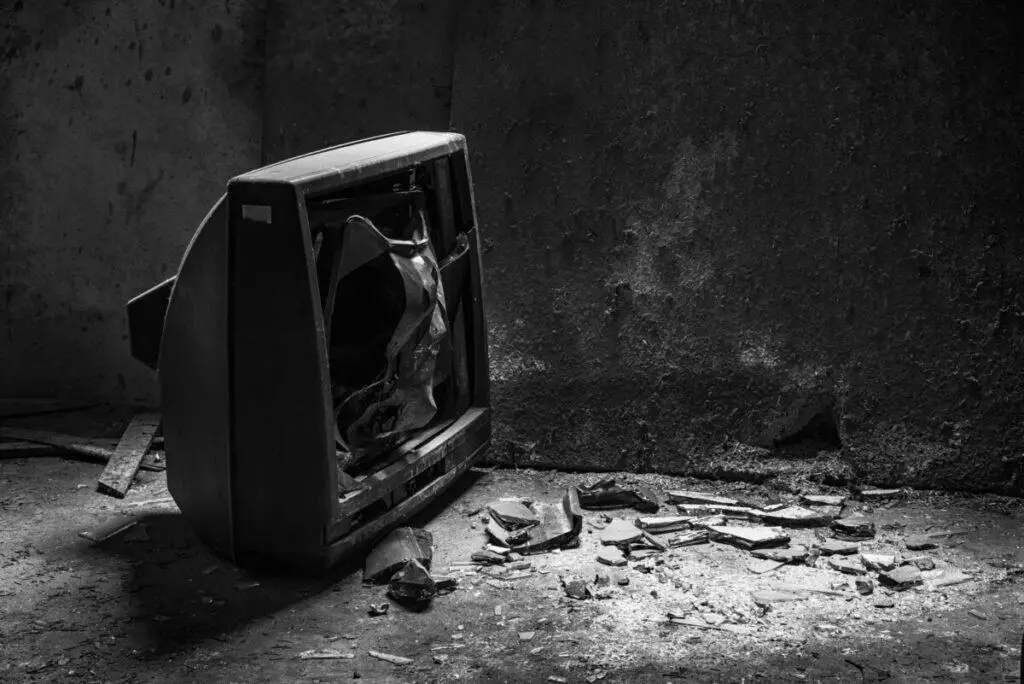Just like any other household appliance, the average television set is not guaranteed to last for a lifetime. When the time comes when you will need to dispose of that old screen, you will need to know the process of disposal. Fortunately, although there are a vast number of different kinds of TVs that exist, the process of disposal is generally the same for each one.
To dispose of any kind of TV, securely remove it from wherever it was attached or standing, place it carefully in a vehicle for transportation, and drop it off at a landfill. Another option would be to show it to a repair person who might scrap it for parts. Also, be sure to see if it can be sold.
I have personal experience in disposing of a certain kind of television screen. The day is sad and somewhat draining, I know. Just rest assured that the process is not overly complicated and that it does not need to take up much of your time.
Box TVs

The earliest and thus the oldest television sets had screens that were made more in the shape of a square and had a more cubical geometry. You can still see examples of these more cubical sets if you visit older establishments such as retirement homes or hospitals. They could even be in your own home if it is old enough! Wherever you find one that either needs replacing or disposing of, it will first need to be completely detached and separated from its original placement.
If the TV is simply resting on a dresser, a counter, or a living room floor, the only thing that needs to be done is to unplug its power cord from the wall. Be sure to pull it out of the electrical socket from the plug and not the cord itself. Pulling on the cord itself will likely cause the cord to snap and continue pulling electricity from the socket, which will create a fire hazard.
Once the TV is detached from its source of power, proceed to lift it from where it was sitting and place it in whatever vehicle will transport it to the landfill. If this box TV was hooked into a sort of metal frame that kept it attached to the wall or the ceiling, then you will have to carefully disassemble the metal frame so the TV can be properly removed.
You will likely need a toolbox with an assortment of different kinds of screwdrivers to loosen the frame from its place. This task may require the assistance of one or more people to avoid injury or further damage. Once the TV is freed from its little cage, only then can you proceed to place it in the vehicle that I mentioned at the beginning of this paragraph.
This kind of TV can be placed on its bottom side in the car just as it had been sitting beforehand. Due to its cubical shape, the likelihood of it falling over and becoming more damaged and thus more of a sharp, glassy mess in need of cleaning up is fairly slim. If you feel that further security is needed, then be sure to tie it to something sturdy or maybe even strap it in with the seat belt.
Those things do not have to only be meant for passengers and booster seats. With the TV secure and gas in the tank, you can make your way to the nearest landfill where you will have the opportunity to rid yourself of that old 4:3 ratio box. Be sure to bring enough money to pay for any entry or disposal fees that the landfill may require.
Flat Screen TVs

The steps in the disposal process for flat-screen TVs are mostly the same as the process for disposing of box TVs. The only thing that causes them to differ is the alternate shape and size. Nowadays, most people seem to prefer flat-screen TVs over box TVs because of their greater convenience and display format capabilities.
Not only that, but they also take up less space and generally have more options when it comes to installation. Regardless, that does not grant them an endless lifespan like one would hope. I would know. One piece of advice I can lend is this: when you buy a flat-screen from a friend for super cheap, do not leave it lying on its back or face in a dark room. You never know when some kids will use that room for hide-and-seek.
Now, if your flat screen TV just stops working while it is in the place it ought to be, then you will need to remove it from wherever it was meant to provide entertainment when it functioned properly. If it sits atop a dresser, a cabinet, or any other flat surface, you simply need to unplug the power cord from the electrical socket as we discussed earlier and carry it to the vehicle that will transport it to the dump.
Depending on the size of this flat-screen TV, you may require the assistance of one or more other individuals in carrying the TV to the vehicle. If the TV was originally attached to the wall by a sort of wall rack, then you will first need to detach the screen from the rack using the proper tools. Definitely have someone help you with this.
As you place the flat-screen TV in the vehicle, be sure to either lay it on its back, on its front, or up against something that you are certain will keep the TV in place. Given how most flat-screen TVs are rather large and too wide to fit into one car seat, I do not think that a seatbelt will keep it in place or even reach the buckle, for that matter. Once secured, make your way to the nearest landfill.
You will need to have a good sum of cash on your person for any entrance or disposal fees. I cannot speak for every landfill out there, but I would say that having at least fifty dollars should be more than enough. Once you are parked near the TV or electronics pile, simply remove the TV from the vehicle and place it amongst its fallen brothers and sisters.
Smart TVs
The newest variation of TV comes in the form of one that can connect to the Internet and provide instant entertainment for the viewer. Typically, the overall shape of this kind of TV is very similar to the flat screen variation. The only difference between the two is that, again, the one that is overwhelmingly deemed as more intelligent than the other provides access to the internet without the need of a separate system hooked up to it.
Basically, you just need to do everything you would do for a flat-screen TV. Also, with the constant rise of technology, there are several different devices and electronic systems that can be hooked up to this TV. Along with the power cord, be sure that all other cords from these devices are unattached to the TV.
No Dumpsters
If you go through with any one of these processes for any kind of television set and screen, I would not recommend taking the TV to a nearby dumpster. The reason I suggest only taking it directly to a landfill rather than presenting the option of dropping it into a dumpster is that any electronic device that is large enough to need two hands to carry is an item that cannot be considered as any other piece of trash when it no longer works.
There are several electrical components within the device that might cause great damage to the equipment used to dispose of most other trash or even cause harm to the workers who run the disposal company. Certain chemicals might even be released by the shattered electrical components that would cause a great deal of harm to both the environment and other human beings. Not only that but the screen is most likely made of glass. I do not think that anyone — not even those wearing protective eyewear or suits — wants to deal with all those shards.
Spare Parts

Now, just because this TV does not work does not mean it is now completely useless. I mean, I am guessing that your TV is malfunctioning beyond repair. Why else would you want to throw it away? Of course, if it can be fixed or donated or given to someone else, then certainly be sure to explore those options. Heck, just sell it if you are able to.
If you are not able to, you also have the option of showing it to an electronics specialist who might be able to find some use for some of the parts that may be reused in one way or another. This option is probably the best one out of all that we have discussed because it provides spare parts for these specialists in building new devices and saves up room for other waste products in the landfill.
I remember moving to another town for college and finding that the mini-fridge that I had for a few years no longer functioned the way it intended to. I soon found no other use for the fridge and sought after different ways to rid myself of this iced ice box.
Soon enough, I learned that a nearby Best Buy regularly takes old, unusable appliances and uses their parts to make newer devices. For me, dropping off that mini-fridge was very easy and the workers were very friendly. I was not paid for my donation, but hey, I certainly will not miss that empty block of nothing taking up space in my place.
I cannot say that I have done the same thing with any kind of TV, but I am willing to bet that they will do something similar with that TV you seek to get rid of. Being one of the biggest electronics distributors in the United States, it probably does not hurt to assume that they will accept any sort of electric appliance meant for entertainment. Of course, do be sure to check with the staff to see if they accept the kind of TV you would like to donate to them.

Make That Money
As I mentioned in the previous paragraph, the TV does not have to be an absolute waste if you can find some way to sell it. You may not receive a full return on your initial purchase, but there is still the possibility of making back a fraction of what you initially spent. I often see different electronic devices being sold on social media that are considered broken by the sellers.
If you can find someone willing to pay for a broken TV, then your problem is solved and now you have some more spending money. You might think that this is unlikely, but I assure you that there are people out there who still enjoy the static of a TV from a past era and might even tinker with old electronics when they have the chance. If you cannot fix it, maybe they can.
To see what pricing you should set your TV at, look online for other broken television sets or really any other sort of electronics that no longer function properly and base your initial pricing on those. In the item description, be sure to loudly proclaim that the TV you are selling is in fact damaged and go into detail on why it no longer works the way it should.
For the most part, the people who browse the sites you post on will generally show no interest in a damaged TV, but as I said before, there are a select few who are looking for this kind of stuff. If these people have questions about the condition the TV is in, provide adequate and explicatory answers. Who knows? They might actually teach you how to fix what is now broken.
Related Topics:
If you like the article above, here are some other similar articles you should check out!
